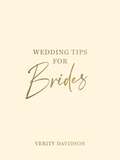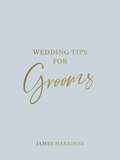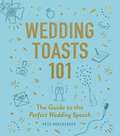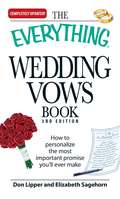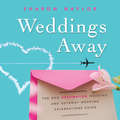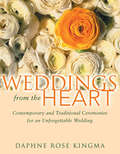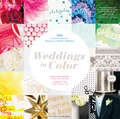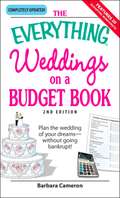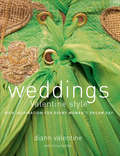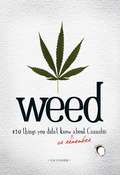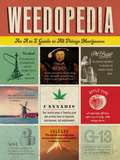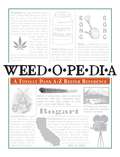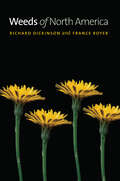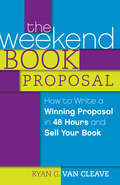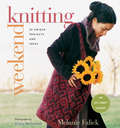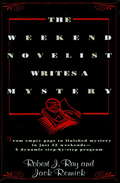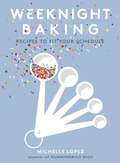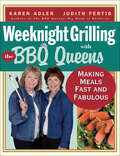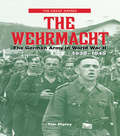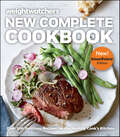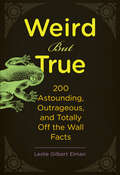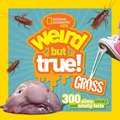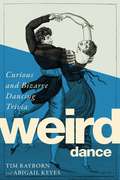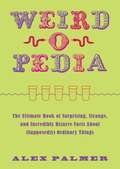- Table View
- List View
Wedding Tips for Brides: Helpful Tips, Smart Ideas and Disaster Dodgers for a Stress-Free Wedding Day
by Verity DavidsonWith clever tips and friendly advice, this little book will ensure that your wedding day runs smoothly, remains catastrophe-free and is full of all the highs you could hope forThe question has been popped, the ring has been presented and the count-down has begun! What's next? Just the wedding.This book is here to ensure that your big day is the magical, memorable event that you've always dreamed of. Taking you through every stage of your wedding - from the night before right up to the honeymoon - it's full of smart ideas to take the stress out of your day, including:Detailed advice for each part of the day, from the ceremony, to the photos, to the cake. Disaster dodgers to help you avoid setbacks. Handy spaces for you to include your own notes. Wedding Tips for Brides presents ingenious ideas for any bride-to-be, and will help you and your partner to get the very most out of your special day.
Wedding Tips for Grooms: Helpful Tips, Smart Ideas and Disaster Dodgers for a Stress-Free Wedding Day
by James HarrisonWith clever tips and friendly advice, this little book will ensure that your wedding day runs smoothly, remains catastrophe-free and is full of all the highs you could hope forThe question has been popped, the ring has been presented and the count-down has begun! What's next? Just the wedding.This book is here to ensure that your big day is the amazing, unforgettable event that you want it to be. Taking you through every stage of your wedding - from the night before right up to the honeymoon - it's full of smart ideas to take the stress away, including: Detailed advice for each part of the day, from the ceremony, to the photos, to the speeches. Disaster dodgers to help you avoid setbacks. Handy spaces for you to include your own notes. Wedding Tips for Grooms presents ingenious ideas for any groom-to-be, and will help you and your partner enjoy your big day to the fullest.
Wedding Tips for Grooms: Helpful Tips, Smart Ideas and Disaster Dodgers for a Stress-Free Wedding Day
by James HarrisonWith clever tips and friendly advice, this little book will ensure that your wedding day runs smoothly, remains catastrophe-free and is full of all the highs you could hope forThe question has been popped, the ring has been presented and the count-down has begun! What's next? Just the wedding.This book is here to ensure that your big day is the amazing, unforgettable event that you want it to be. Taking you through every stage of your wedding - from the night before right up to the honeymoon - it's full of smart ideas to take the stress away, including: Detailed advice for each part of the day, from the ceremony, to the photos, to the speeches. Disaster dodgers to help you avoid setbacks. Handy spaces for you to include your own notes. Wedding Tips for Grooms presents ingenious ideas for any groom-to-be, and will help you and your partner enjoy your big day to the fullest.
Wedding Toasts 101: The Guide to the Perfect Wedding Speech
by Pete HonsbergerWrite and present a memorable wedding toast with this light-hearted, humorous guide that gives you all the tools you&’ll need for a successful speech—the perfect gift for any best man or maid of honor. As much as it&’s an honor to be chosen as the best man or maid of honor at a wedding, giving the perfect speech can sometimes be nerve-wracking. Delivering a crowd-pleasing toast at the reception that has the right amount of humor and sentimentality is a daunting undertaking, no matter how advanced your public speaking skills are. Pete Honsberger&’s guide to giving the perfect wedding toast provides even the most nervous of public speakers with all the tools and advice they need for writing and presenting the best toast ever. After witnessing speeches both good and bad, Honsberger shares a few bits of wisdom he&’s learned along the way, providing building blocks to creating an unforgettable story along with helpful speech prompts, and the perfect checklist that will turn a potentially scary obligation into a golden opportunity. Wedding Toasts 101 presents a fun and simple way to write a successful wedding toast without all the stress so you can spend less time worrying and more time celebrating the happy couple.
Wedding Vows Book (The Everything )
by Don Lipper Elizabeth SagehornWriting personalized wedding vows is a wonderful way to make the big day that much more special. Packed with ideas, insights, and inspiration, this completely revised third edition helps you declare your love in a uniquely personal way. This book features information on how to develop meaningful, personal wedding vows, incorporate a favorite song or poem, get family members involved, include children, and more! For extra fun, this book also includes celebrity wedding vows and great love lines from the movies. This is the only book you need to create the perfect statement for their new life with their partners.This edition includes completely new material on: ethnic vow traditions from around the world, vows incorporating holidays and nature, and vows for same-sex ceremonies.
Weddings Away: The New Destination Wedding and Getaway Wedding Celebrations Guide
by Sharon NaylorNow that you’ve said, “I do” to having a destination wedding, it’s time to make your fairy tale getaway celebration a reality! Whether you’re planning an island wedding, overseas nuptials, or an intimate gathering in a beloved beach house or a charming village close to home, this invaluable guide from go-to wedding expert Sharon Naylor gives you all the information you need to make your magical day meaningful, memorable, and carefree—for you, and for your guests! You’ll discover: *How to choose the right planner—and how to get the most out of your on-site wedding professionals * Up-to-date wedding etiquette and planning tips from celebrity wedding planners and experts * New ways to use social media accounts, blogs and apps for info-gathering and inspiration * Invaluable advice for when it’s a destination wedding for out-of-town guests but not for the couple *How to plan amazing and unforgettable destination wedding weekend outings and events *Great ideas for getaway bachelor or bachelorette parties, as well as arranging a romantic pre-wedding escape for you to reconnect with your beloved before the big day! * Must-have tips and to-dos for your destination wedding scouting trips From navigating travel trends and social media to benefitting from little-known freebies, this comprehensive guide to planning your wedding from afar is brimming with information you won’t easily find anywhere else. Weddings Away has everything you need to keep your happily-ever-after stress-free and smooth sailing!
Weddings from the Heart: Contemporary and Traditional Ceremonies for an Unforgettable Wedding
by Daphne Rose Kingma&“Will help any couple understand the meaning behind the wedding ceremony and create the most exquisite ceremony possible. Movingly written . . . &”—Midwest Book Review When you&’re planning your marriage ceremony, it can feel like the to-dos and checklists are endless. But at the end of the day, it&’s about you and your relationship. It&’s not about impressing people with your perfectly iced cake or your breathtaking venue, it&’s about honoring your love. This means crafting a ceremony that reflects your relationship and is as unique and special as your bond is. Relationship expert and &“love doctor&” Daphne Rose Kingma is here to help you plan a day that is a deeply moving experience—one that you won&’t even need photographs to remember (but of course, they&’re still nice to have!). She reminds us that it&’s the essence of the ceremony that matters. And this comes from the words that are exchanged in your wedding vows, the atmosphere you create, and the love generated through each special moment. Whether you want a traditional wedding or a contemporary ceremony, there is a way to celebrate the day that is true to you. Open this book up and find: · Five different types of ceremonies you can use · Inspiration and examples of vows · Worksheets to guide you through creating a personalized wedding day Readers of books like A Practical Wedding Planner, The Bride&’s Instruction Manual, Love Poems, and The Knot Yours Truly will love Kingma&’s Weddings from the Heart.
Weddings in Color: 500 Creative Ideas for Designing a Modern Wedding
by Minhee Cho Vane Broussard Jaine M. KershnerIn this guide, Vané Broussard (founder of the uber-popular blog Brooklyn Bride) and Minhee Cho (of the covetable paper company Paper+Cup) team up to present hundreds of entirely modern style ideas for every aspect of a wedding, in eight eye-catching and vibrant color palettes. <P><P>From pretty floral crowns to die-cut invitations, altars made from balloons, and so much more, these ideas are anything but traditional. Simple DIYs will spark creativity while interviews with industry experts provide important insider info. Lusciously designed and bursting with vivid photography, Weddings in Color has everything brides need to design a stunningly colorful affair.
Weddings on a Budget Book (The Everything )
by Barbara CameronNot every couple has a bottomless bank account to pay for their wedding. Filled with 20 financial- and time-budgeting worksheets this book is a must-have for DIY brides-to-be who want to make the biggest day of their lives as memorable as possible - without breaking the bank.
Weddings Valentine Style
by Tonya Bolden Diann ValentineDiann Valentine makes magic and weaves dreams. For more than a decade, she has produced inimitable celebrations of love for a host of top talents, as distinct as Lela Rochon and Antoine Fuqua, DeLeon and Gary Sheffield, and Kelis and Nas, in cities as different as Toledo, Ohio, and the Big Apple. "I'm definitely living up to my name," says Valentine. In Weddings Valentine Style, this unabashed romantic with a commitment to quality and a keen eye for excellence reminds readers that a classy, unforgettable wedding is not about merely serving up fine caviar and champagne but rather about envisioning the triumph of a stunning centerpiece composed of a single stem of dendrobium orchids rather than a crowd of carnations or mums. Ultimately, Valentine insists, "It's about making choices that speak to your own beat." Valentine has been featured in InStyle, Essence, O: The Oprah Magazine, and Grace Ormonde Wedding Style, among other periodicals, as well as on InStyle Celebrity Weddings, Entertainment Tonight, E! News Daily, and VH1 Rock N' Roll Weddings. She receives constant applause for her extraordinary ability to trump continuously her own creativity in producing one-of-a-kind celebrations, her energy never failing from vision to execution. Her signature style is clean, simple elegance with touches of eclecticism, meshing tradition and innovation. And in Weddings Valentine Style, she offers lovebirds with and without big budgets a treasury of information and inspiration for dreamweaving a glorious "I Do" day.
Weed
by I. M. StonedWeed. Pot. Mary Jane. Grass. No matter what you call marijuana, it's still dope.In this irreverent and all-inclusive look at cannabis, you will learn all there is to know about the psychoactive substance Bill Clinton didn't inhale - but many others did - including:How pot can help cure a hangoverWhy The Man really doesn't want to legalize weedHow to make a bong from an appleThe real deal behind Reefer MadnessAnd more!From how to grow it, ways to consume it, and places to hide it, to myths debunked, stupid crimes, and pot in pop culture, this smokin' book is guaranteed to keep you giggling - long after the buzz wears off.
Weedopedia: An A to Z Guide to All Things Marijuana
by Adams MediaDiscover everything you&’ve ever wanted to know about marijuana all in one place with this authoritative A-to-Z guide to cannabis!What&’s a wake and bake? Who is Mitch Hedberg? What does Louisa May Alcott have to do with cannabis? And what exactly is the difference between a bong and a bubbler? Now you can &“weed&” all about it and find all the answers and more with this entertaining and updated edition of Weedopedia, your guide to everything marijuana—from the best movies to watch while high to cannabis slang and terminology. Whether you&’re interested in learning more about all things marijuana, or if you want something entertaining to read while enjoying a toke, this book is the one-stop-shop for all your weed-related needs.
Weedopedia: A Totally Dank A-Z Reefer Reference
by Will B. HighThere's more to marijuana than smoking it. And in this one-stop, one-stoke resource, you'll learn it all. With more than 800 entries covering everything from Afghan Kush to Zombieland, this awesome collection of all things cannabis is packed with information and illustrations every stoner should know, including: Why the subtle flavor of bubbleberry makes it a rich pothead's drug of choice, How to properly make a bong out of a coconut for maximum highness, How high you should be to watch a Jack Black movie, The real way to get stoned at festivals like the Hash Bash, Why Barack Obama and Michael Phelps are really role models. It's the reference no stoner should be without! This book gives you what you need to know to be at the head of the class--at least while you're passing around a joint.
Weeds of North America
by Richard Dickinson France RoyerAmerican Horticultural Society Book Award Winner: “An essential reference for all who wish to understand the science of the all-powerful weed.” —Better Homes and Gardens“What is a weed,” opined Emerson, “but a plant whose virtues have not yet been discovered?” While that may be a worthy notion in theory, these plants of undiscovered virtue cause endless hours of toil for backyard gardeners. Wherever they take root, weeds compete for resources, and most often win. They also wreak havoc on industry—from agriculture to golf courses to civic landscape projects, vast amounts of money are spent to eradicate these virile and versatile invaders. With so much at stake, reliable information on weeds and their characteristics is crucial. Richard Dickinson and France Royer shed light on this complex world with Weeds of North America.Organized by plant family, this encyclopedic volume features over five hundred species in two-page spreads with images and text identification keys. Species are arranged within family alphabetically by scientific name, and entries include vital information on seed viability and germination requirements. No matter what your philosophy on weeds, this guide provides much-needed background on these intrusive organisms. In the battle with weeds, knowledge truly is power, and Weeds of North America is perfect for gardeners, botanists, nature lovers, or anyone working in the business of weed ecology and control.“Royer’s photographs are almost perversely alluring. . . . How can you not be ensnared by a book populated by prostrate pigweed, tansy ragwort and dog-strangling vine?” —New York Times Book Review
The Weekend Book Proposal: How to Write a Winning Proposal in 48 Hours and Sell Your Book
by Ryan G. Van CleaveWrite Better Proposals Faster to Accelerate Your Writing Career! Whether you are a true beginner or a seasoned writer looking to secure more book contracts, The Weekend Book Proposal shows you how to take your best ideas and create powerful proposals--quickly and professionally. No need to spend months laboring over a proposal when in just a few days you can write one that will ignite the interest of agents and editors. Ryan G. Van Cleave presents the tools you need to craft an eye-grabbing proposal for your nonfiction, memoir, anthology, textbook, novel, and more. Jam-packed with proven strategies, nuts-and-bolts advice, sample queries and proposals, interviews with publishing experts, and "Hit the Gas" tips for speeding up the proposal process, The Weekend Book Proposal will show you how to succeed and prosper as a writer--and sell your books before you've even written them! The Weekend Book Proposal explains how to: Write a catchy title and book description. Create a compelling author bio and chapter outline. Develop a targeted, engaging concept statement. Build a strong marketing plan and endorsements list. Structure your proposals based on those crafted by successful authors.
Weekend Knitting: 50 Unique Projects and Ideas
by Melanie FalickProjects you can finish in two days or less—with clear instructions and beautiful photos—for both beginners and experienced knitters! When Weekend Knitting was first published in hardcover in 2003, a modern generation of knitters was just starting to discover this "hot new hobby." Since then, knitting has grown wildly popular and Melanie Falick&’s book has gone on to become a knitting classic and a huge bestseller.Weekend Knitting brings together unique, innovative, and still-fresh projects for beginning and more-experienced knitters, many of which can be completed in a weekend or less. Every project is presented with clear instructions and in beautiful photographs that celebrate idyllic weekend settings. Quotes from diverse sources about knitting, creativity, and balanced living—along with favorite recipes, lists of books and movies with knitting scenes, and other extras—complete the weekend knitting experience.
The Weekend Novelist Writes a Mystery
by Robert J. RayLike Agatha Christie and Raymond Chandler, Sara Paretsky and Thomas Harris, you, too, can learn the trade secrets of quality detective fiction.It's true. Just one year from now, you can deliver a completed mystery novel to a publisher--by writing only on weekends. Authors Robert J. Ray and Jack Remick guide you through the entire mystery-writing process, from creating a killer to polishing off the final draft. Each weekend you'll focus on a specific task--learning the basics of novel-writing, the special demands of mystery-writing, and the secrets professionals use to create stories one scene at a time, building to a shivery, satisfying climax. Using Agatha Christie's The Body in the Library as a model for the classical mystery tale and Martin Cruz Smith's Gorky Park for the hard-boiled mystery, this unique step-by-step program gives you all the information you need to reach your ultimate goal: a finished book in just 52 weeks! Let two successful masters of the genre show you how...Discover: Why you must create your killer first The tricks to writing dialogue that does it all--moves your plot, involves your reader, and makes your style sizzle How to "bury" information (and corpses) for your reader to find Why you should NOT build your book around chapters Special techniques for clearing writer's block Plus: examples from Sue Grafton, Dashiell Hammett, Patricia Cornwell, Thomas Harris, Raymond Chandler, and more.From the Trade Paperback edition.
Weeknight Baking: Recipes to Fit Your Schedule
by Michelle LopezMichelle Lopez—the wildly popular and critically acclaimed blogger behind Hummingbird High—teaches busy people how to make cookies, pies, cakes, and other treats, without spending hours in the kitchen.If anyone knows how to balance a baking obsession with a demanding schedule, it&’s Michelle Lopez. Over the past several years that she&’s been running her blog Hummingbird High, Lopez has kept a crucial aspect of her life hidden from her readers: she has a full-time, extremely demanding job in the tech world. But she&’s figured out how to have her cake and eat it too. In Weeknight Baking, Lopez shares recipes for drool-worthy confections, along with charming stories and time-saving tips and tricks. From everyday favorites like &“Almost No Mess Shortbread&” and &“Better-Than-Supernatural Fudge Brownies&” to showstoppers like &“a Modern Red Velvet Cake&” and &“Peanut Butter Pretzel Pie&” (it&’s vegan!), she reveals the secrets to baking on a schedule. With rigorously tested recipes, productivity hacks, and gorgeous photographs, this book is destined to become a busy baker&’s go-to. Finally, dessert can be a part of every everyday meal!
Weeknight Grilling with the BBQ Queens: Making Meals Fast and Fabulous
by Karen Adler Judith Fertig“The authors of the BBQ Queens’ Big Book of Barbecue apply their trademark can-do spirit to the ever-popular weeknight dinner format.” —Publishers WeeklyThe BBQ Queens are back to show the world that grilling is not just for the weekend! In Weeknight Grilling with the BBQ Queens, Karen Adler and Judith Fertig offer 100 easy and versatile recipes for weeknight dinners on the grill, and most can be prepared in 45 minutes or less. The Queens’ straightforward, fun-loving approach shakes up the monotonous routine of cooking dinner and gives busy people everything they need to get healthy, great-tasting meals on the table quickly.All the recipes and suggestions needed for each dinner are included on a two-page spread for maximum convenience, and the ingredients called for are either readily available in grocery stores or already sitting in the pantry. The BBQ Queens explain a variety of grilling techniques, such as skewering and stir-grilling; offer Time-Saving Tiara Touches providing shortcuts and other ways to streamline dinner prep; and include recipes for turning grilled leftovers into wonderful new dishes.Weeknight Grilling with the BBQ Queens makes dinner preparation such a snap that the only difficulty is in choosing which of the mouthwatering dishes to serve, such as Grilled Flank Steak with Avocado Salsa Verde and Grilled Corn; Asiago Grilled Chicken Breasts with Linguine Marinara; Lime-Basil Shrimp with Grilled Polenta and Asparagus; Grilled Vegetable Roll-Ups with Feta-Olive-Lemon Filling; Mesquite-Grilled Pasta Salad with Chicken, Peaches, and Cashews; or Tandoori Turkey Burgers with Onion, Tomato, and Cucumber Raita. These user-friendly recipes harness the power of the grill to make tasty, nutritious meals easily achievable all week, every week.
The Wehrmacht: The German Army in World War II, 1939-1945
by Tim RipleyTo see the foreword, the introduction, a generous selection of sample pages, and more, visit the website The Wehrmacht website.In this unique volume, expert Tim Ripley introduces the reader to the world of the German army, covering in detail concepts such as mobile defense and the formidable Blitzkrieg, and explains why the Wehrmacht was able to fight so long, with such fearsome effectiveness. Also includes 180 color and black and white maps and illustrations.
Weight Watchers New Complete Cookbook, Smartpoints™ Edition: Over 500 Delicious Recipes for the Healthy Cook's Kitchen
by Weight WatchersThe world’s leading provider of weight management services offers a cookbook for home cooks, completely updated with SmartPoint™ Information.Weight Watchers® knows the secrets for pairing good nutrition with great taste. From hearty breakfasts to flavorful dinners, discover new recipes that rely on lean meats, whole grains, and fresh produce. Try new favorites like Cremini Mushrooms with Quinoa and Thyme or Swiss Chard au Gratin, or family standbys like Buttermilk-Blueberry Corn Muffins and Sicilian Sausage-Stuffed Pizza. Reflecting the current trends in food, this edition boasts new chapters on Appetizers and Beverages, featuring a no-cook cocktail party; Small Plates, for creating tapas for light meals; Meals from the Grill, complete with grilling information; twenty-Minute Main Dishes, including shopping and streamlining advice; plus numerous tips and techniques. With more than sixty color photos, this is the book to help make everyone healthier and happier. Includes new SmartPoints values, information on SmartPoints, and updated recipes.
Weird But True: 200 Astounding, Outrageous, and Totally Off the Wall Facts
by Leslie Gilbert ElmanBizarre and fascinating facts for fans of science, nature, history, and more!The Earth is broadcasting a symphony of sound right now . . . Madagascar is home to enormous suicidal palm trees . . . Blacktip sharks can reproduce by virgin birth . . . In this fascinating book, weird, true facts like these reveal just how much freaky stuff really happens around the world.We’ve uncovered odd natural phenomena, super-strange historic occurrences, downright bizarre momentous discoveries, and totally peculiar coincidences that will blow your mind. From Biblical latrines to ultimate survivor microbes, if it’s weird—and true—you’ll find it here!
Weird but true! GROSS: 300 Slimy, Sticky, and Smelly Facts (Weird But True Series)
by National Geographic KidsThis 'Weird But True' title is slimy and sticky and jam-packed with more icky, zany fun! Step up to the plate and try not to lose your lunch, with 300 amazing facts plus photos that kids just can't get enough of.
Weird Dance: Curious and Captivating Dance Trivia
by Tim Rayborn Abigail KeyesAttend a grand ball of the bizarre and never look at dance the same way again!Weird Dance processes through the odd, grim, and unintentionally humorous history of dance, uncovering strange stories and weird facts.These dark tales of murder, rivalry, insanity, and more reveal all sorts of grim goings-on, proving that—for dancers—life was not just one grand plié. Stories include: An elderly woman who stepped out of her Strasbourg home one summer day in 1518 and began to dance furiously; nothing and no one could stop her. Soon, dozens more joined her, and so began another strange epidemic of the deadly dancing plague. The horrific fate of a young ballerina who had a run-in with a gaslight and saw her career go up in smoke. The medieval Dance of Death that reminded all of their inevitable doom. The controversial ballet that sparked a riot. The strange and macabre fate of the infamous Mata Hari’s head after her execution. The grotesque scarf accident that led to Isadora Duncan’s demise.From Roman Bacchanals to medieval and Renaissance dancing plagues, from the bloody world of ballet to scandals, ghosts, spirit possessions, superstitions, and more, you will attend a grand ball of the bizarre that shows just how awful dancers, choreographers, and even audience members have been to each other over the centuries.
Weird-o-pedia: The Ultimate Book of Surprising Strange and Incredibly Bizarre Facts About (Supposedly) Ordinary Things
by Alex PalmerCheck out the weird and wonderful facts in this massive encyclopedia of alphabetized oddities:* HUMANS ARE THE ONLY ANIMALS THAT ENJOY SPICY FOOD (there's a reason no one sells Tabasco-flavored cat food)* NAPPING CAN SAVE YOU FROM A HEART ATTACK (assuming you are not operating heavy machinery at the time)* PSYCHOLOGISTS CAN ASSESS YOUR PERSONALITY FROMHOW YOU DIP FRIES IN KETCHUP (nice fries, sociopath)* SURFING THE INTERNET ACTUALLY MAKES YOU SMARTER (but not as smart as reading this book will)Now the next time someone tells you smugly that Pluto isn't a planet,you can counter with any one of these hundreds of weird facts and remain king or queen of the cocktail (or kegger) chatter.
